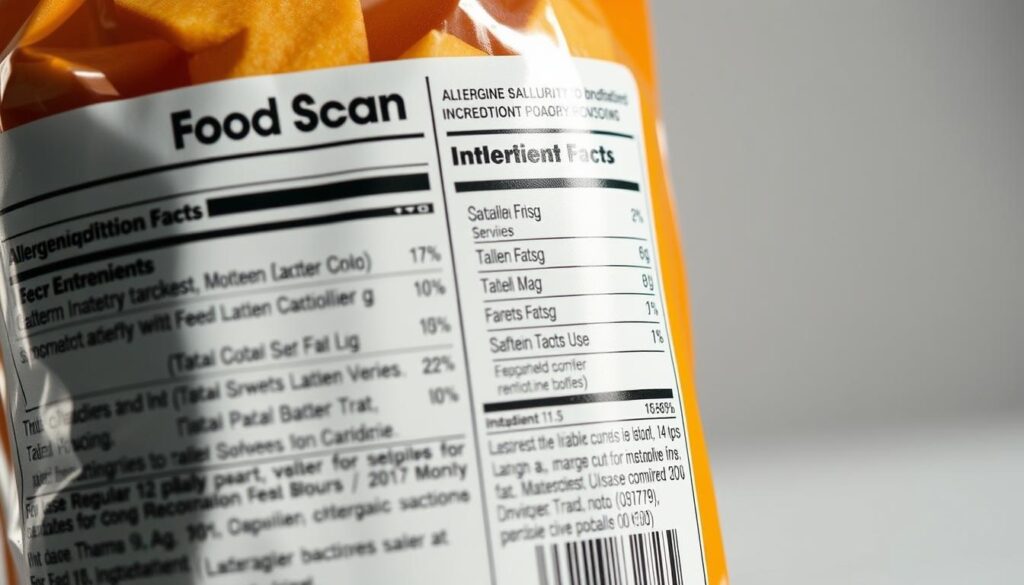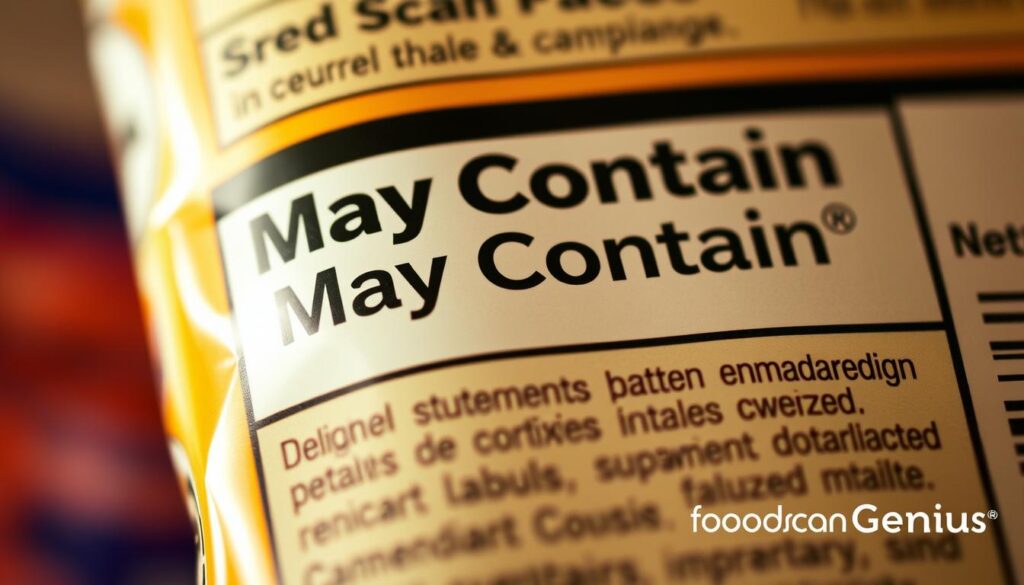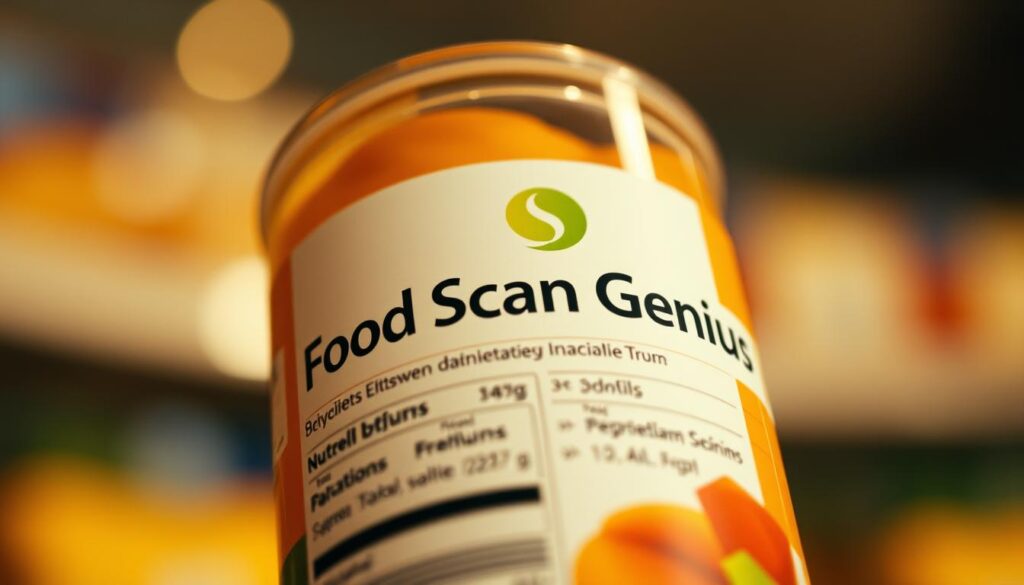Reading Ingredient Labels for Food Allergies While Shopping
We’ve all been there—standing in the aisle, squinting at a product package, trying to decipher the tiny print. For those managing health concerns like food sensitivities, this moment can feel overwhelming. But it doesn’t have to be. Understanding what’s in your food label is the first step toward staying safe and confident.
Did you know that federal laws like FALCPA and the FASTER Act require manufacturers to clearly disclose major allergens? Yet, even with these regulations, changes in product formulations can happen without warning. That’s why it’s crucial to check every label, every time.
To make this easier, we’re thrilled to share the Food Scan Genius app—your ultimate AI assistant for navigating the grocery store. It’s designed to help you quickly identify potential risks and make informed choices. Download it today and take the guesswork out of your next shopping trip!
Key Takeaways
- Federal laws like FALCPA and the FASTER Act ensure allergen disclosure.
- Always check labels, even for familiar products, as ingredients can change.
- The Food Scan Genius app simplifies the process of identifying allergens.
- Advisory statements like “may contain” are voluntary and not regulated.
- Early education on label reading can empower those with food sensitivities.
Overview of Food Allergies and the Importance of Label Reading
Navigating the grocery store can feel like a puzzle for those with dietary restrictions. For millions of Americans, a simple product choice can lead to serious health risks. That’s why understanding food allergens and how they’re labeled is so important.
Understanding Food Allergies in Everyday Life
Common allergens like milk, eggs, peanuts, and sesame can trigger reactions ranging from mild discomfort to life-threatening situations. For example, someone with a peanut allergy might experience hives, swelling, or even anaphylaxis. This makes it crucial to know what’s in your food before you eat it.
Modern laws like FALCPA and the FASTER Act require manufacturers to clearly label these allergens. Yet, even with these rules, products can change without notice. That’s why every packaged food deserves a second look.
The Role of Accurate Labeling in Allergen Safety
Accurate labeling is more than just a convenience—it’s a lifeline. The FDA enforces strict standards to ensure consumers can identify potential risks. For instance, ingredient lists must highlight major allergens like soy or tree nuts.
Here’s what you need to know:
- Major allergens like milk, egg, and sesame are now clearly marked.
- Even familiar items can have hidden risks, so always check the label.
- Tools like the Food Scan Genius app make it easier to spot potential dangers.
By staying informed, you can shop with confidence and keep your health a top priority.
Decoding Regulatory Standards and Industry Guidelines
Federal laws play a big role in how allergens are listed on packaging. These rules ensure that consumers can quickly identify potential risks. Two key regulations—FALCPA and the FASTER Act—set the standard for allergen labeling in the U.S.

Key Points of FALCPA and the FASTER Act
The Food Allergen Labeling and Consumer Protection Act (FALCPA) requires manufacturers to clearly list the top eight allergens. These include milk, eggs, peanuts, tree nuts, soy, wheat, fish, and shellfish. The law ensures these allergens are bolded or highlighted on every label.
In 2021, the FASTER Act added sesame as the ninth priority allergen. This change reflects growing awareness of sesame-related reactions. Both laws aim to make labeling more transparent and consistent.
How Regulations Influence Label Clarity
These laws don’t just protect consumers—they also hold manufacturers accountable. For example, the FDA requires that allergens be listed in plain language. This means “casein” must be labeled as “milk,” and “albumin” as “egg.”
Here’s how these rules make a difference:
- Major allergens are easy to spot on every product.
- Changes in formulations must be reflected on the label.
- Precautionary statements like “may contain” are voluntary but still helpful.
By following these guidelines, manufacturers help reduce risks and build trust with consumers. It’s a win-win for everyone!
Precautionary Statements and “May Contain” Labels
Ever wondered what those “may contain” labels really mean? They’re often found on packaged items, but their purpose isn’t always clear. Let’s break it down in simple terms so you can shop with confidence.

Interpreting “May Contain” and Advisory Warnings
When you see “may contain” on a label, it’s a heads-up from the manufacturer. It means there’s a chance the product could have come into contact with an allergen during production. For example, a chocolate bar might say, “May contain traces of nuts.”
These statements are voluntary, not required by law. The FDA doesn’t regulate them, so their absence doesn’t guarantee safety. Always double-check if you’re unsure.
Distinguishing Voluntary Claims from Mandatory Disclosures
Mandatory disclosures are different. Laws like FALCPA require allergens like milk or eggs to be clearly listed. But “may contain” warnings are optional. Here’s a quick comparison:
| Feature | Mandatory Disclosures | Voluntary Claims |
|---|---|---|
| Regulation | Required by law | Optional |
| Examples | “Contains: Milk” | May contain traces of peanuts” |
| Purpose | Ensure transparency | Provide additional caution |
If you’re ever in doubt, don’t hesitate to contact the manufacturer. They can provide clarity on their processes and help you make informed choices. Remember, your health is worth the extra step!
reading ingredient labels for food allergies while shopping
Shopping for safe options can feel like a maze, but with the right approach, it’s manageable. We’re here to walk you through a simple, step-by-step process to ensure you’re making informed choices every time.
Step-by-Step Guide to Examining Packaged Foods
Start by scanning the ingredient list from top to bottom. Look for bolded or highlighted words, as these often indicate major allergens like milk, eggs, or peanuts. Don’t stop there—read the entire list to catch any hidden risks.
Next, check for advisory statements like “may contain” or “processed in a facility with.” These warnings aren’t regulated by the FDA, but they can provide valuable insight into potential cross-contamination.
Finally, if you’re unsure about a product, don’t hesitate to contact the manufacturer. They can clarify their processes and help you make a safe choice.
Identifying Hidden Allergens on Labels
Sometimes, allergens hide under unfamiliar names. For example, “casein” means milk, and “albumin” refers to eggs. Knowing these synonyms can help you spot risks that aren’t immediately obvious.
Be cautious with terms like “natural flavors.” While they sound harmless, they might include undisclosed allergens. When in doubt, reach out to the manufacturer for clarity.
Here’s a quick checklist to keep in mind:
- Read the entire ingredient list, not just the highlighted parts.
- Look for advisory statements and understand their implications.
- Use tools like the Food Scan Genius app to simplify the process.
By following these steps, you can shop with confidence and reduce the risk of an unexpected reaction. Your safety is worth the extra effort!
Navigating Technology: The Food Scan Genius App
Technology is changing the way we approach everyday challenges, especially in the grocery store. For those managing dietary restrictions, the Food Scan Genius app is a game-changer. It’s designed to make allergen-safe shopping simpler, faster, and more reliable.
How the App Enhances Your Shopping Experience
With just a quick scan, the app analyzes labels to identify potential risks. It uses advanced AI to highlight allergens like milk, eggs, and peanuts, so you can make informed choices instantly. No more squinting at tiny print or second-guessing unfamiliar terms.
The app also caters to a variety of dietary needs, including gluten-free, vegan, and vegetarian preferences. Whether you’re shopping for yourself or your family, it’s like having a personal assistant in your pocket.
Download for iOS and Android
Ready to simplify your next trip to the store? Download the Food Scan Genius app today! It’s available for both iOS and Android devices, making it accessible to everyone. Join our community of informed shoppers and take the guesswork out of allergen labeling.
Your safety is our priority. With the app, you can shop confidently, knowing that technology and clear labeling go hand-in-hand to keep you safe. Don’t wait—get started now at https://food.scangeni.us!
Practical Tips for Safe Grocery Shopping and Label Verification
Creating a safe shopping routine starts with small, consistent steps. Whether you’re managing a food allergy or simply want to stay informed, these tips will help you navigate the aisles with confidence.
Developing Consistent Label-Reading Habits
Consistency is key when it comes to checking labels. Make it a habit to review every product, even if it’s something you’ve bought before. Ingredients can change without warning, so it’s always better to double-check.
Here’s a quick routine to follow:
- Scan the ingredient list for bolded or highlighted allergens.
- Look for advisory statements like “may contain” or “processed in a facility with.”
- If you’re unsure, don’t hesitate to contact the manufacturer for clarification.
Verifying Labels at Home and Beyond
Your safety doesn’t stop at the store. Once you’re home, take a moment to review the label again. This extra step ensures you didn’t miss anything during your shopping trip.
If you’re traveling or trying a new product, remember that labeling standards can vary by country. Always stay vigilant and ask questions when needed.
Your health is worth the extra effort. Taking a few seconds to check a label can make all the difference.
When in Doubt, Reach Out
Manufacturers are there to help. If a label seems unclear or you’re unsure about a specific ingredient, give them a call. Many companies have dedicated teams to assist consumers with dietary concerns.
Here’s a quick comparison of when to act:
| Situation | Action |
|---|---|
| Unclear label | Contact the manufacturer |
| Advisory statement | Proceed with caution |
| No label on bulk items | Avoid purchasing |
By following these steps, you can turn label-checking into a seamless part of your routine. Remember, your safety is always a team effort—and we’re here to help every step of the way!
Conclusion
Managing dietary needs doesn’t have to be overwhelming—let’s make it simple and stress-free. Staying informed about allergens and regulatory standards is essential for every consumer. By adopting consistent habits, like double-checking every product, you can reduce risks and shop with confidence.
Tools like the Food Scan Genius app are here to simplify the process. It’s your pocket-sized ally, helping you spot potential allergens quickly and accurately. With support from the FDA and clear labeling laws, you’re never alone in this journey.
We encourage you to share your tips and experiences with our community. Together, we can make safe choices easier and more accessible. Download the app today and join us in creating a safer, smarter shopping experience!
FAQ
Why is it important to read labels if I have a food allergy?
Reading labels helps you avoid allergens that could trigger a reaction. It’s a simple way to stay safe and confident about what you’re eating.
What does “may contain” mean on a label?
“May contain” is a precautionary statement indicating that the product might have traces of allergens due to shared equipment or facilities. It’s best to avoid these if you’re highly sensitive.
Are all allergens clearly listed on labels?
In the U.S., major allergens like milk, eggs, and nuts must be listed by law. However, hidden allergens or cross-contamination risks might not always be obvious, so it’s important to read carefully.
How can the Food Scan Genius App help me?
The app makes label reading easier by scanning products and highlighting potential allergens. It’s a handy tool for safer, stress-free shopping. Download it for iOS and Android at https://food.scangeni.us.
What should I do if I’m unsure about an ingredient?
When in doubt, contact the manufacturer directly. They can provide detailed information about their product and its allergen risks.
Are there specific words I should look for on labels?
Yes! Words like “casein” (milk), “albumin” (egg), or “lecithin” (soy) can indicate hidden allergens. Familiarize yourself with these terms to stay informed.
Can I trust “gluten-free” or “allergen-free” claims?
While these claims are regulated, it’s still wise to check the label for cross-contamination warnings or other allergens that might affect you.
How often do food labels change?
Labels can change anytime a recipe or manufacturing process is updated. Always double-check, even if it’s a product you’ve bought before.






7 Comments
[…] for animal products is more complex than ever. Whether you’re vegan, allergic, or simply curious, understanding ingredient lists can be daunting. This guide explores how to scan food labels for animal products, compares US and […]
[…] many flavors—especially cheese, creamy, or masala varieties—do contain milk ingredients. Always check the label or scan before […]
[…] of these snacks is 100% vegan and meets the latest US food labeling standards. For those with food allergies or sensitivities, always check the packaging or use a food scanning app for extra […]
[…] Mandatory for 8 major allergens (milk, egg, fish, etc.) […]
[…] Scan Genius is the top-rated choice, thanks to its AI-powered ingredient analysis, allergen alerts, and global regulatory […]
[…] Top 9 allergens must be listed […]
[…] Fresh fruit, packaged polenta chips, and certified gluten-free cookies are safe bets. Always double-check labels for cross-contamination […]